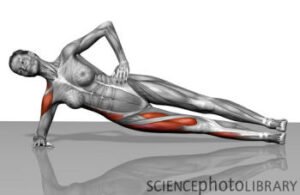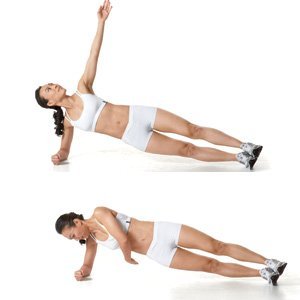AN IMPORTANT NOTE: individuals with serious wrist, elbow, or shoulder injuries should avoid this pose.
The Plank is typically a static exercise for strengthening the abdominals, back and shoulders. The plank great for strengthening the transverse abdominus. The transverse abdominus is the deepest of the abdominal muscle and wraps around the whole midsection. When you contract the abdominals, your waist becomes thinner. This is what the transverse abs do. So you can see that strong transverse abs means a smaller, tighter waist. When you are doing the plank exercise or a variation of the plank such as the side version described here, make sure to contract your abdominals while remembering to breath.

The side plank is an important part of your core fitness training will challenge your stability and improve your core strength by working the muscles along the side of your body.
Muscles involved include:

- Primary:
- transverse abdominus,
- gluteus medius
- gluteus minimus muscles (abductors)
- adductor muscles of the hip
- the external and internal obliques
- Secondary:
- gluteus maximus (glutes)
- quadriceps (quads)
- hamstrings
How to do it:

- Lie on your right side, raising yourself onto your right forearm.
- Place your right shoulder directly above your right elbow, keeping your shoulders, hips and knees in one straight line.
- Rest your left arm along the side of your body.
- Before you press up, draw your abs in, drop your shoulders away from your ears, and lengthen your spine.
- Push up so that you body is straight… Hold for 10 seconds for beginner to 1 Minute if more advanced. Repeat on your left side.
Advanced variation:
- Push up so that you body is straight, then raise your left arm to the ceiling, while keeping your body straight lower your left arm to reach under and behind you (bottom image), then raise it up again. Do this 20 times… repeat on the other side.
Technique points:
1) Arm Positioning – Your Elbows must be placed directly beneath the shoulders – in one line. Weight should be placed beneath your upper arms, under your elbows, with no additional weight on the forearms, wrists or hands.
2) Shoulder Position – Shoulders must be released down from the ears to help connect the structure of the arms to the the core muscles. Actively contract the lat muscles of your back to help pull the shoulders down into the proper position.
3) Spinal alignment – The spine should be lengthened. Lift your head away from your shoulders, lengthening your neck while simultaneously reaching your tailbone in the other direction. Maintain this long spine throughout the entire duration of the exercise.
4) Breathing Technique – It is very important in this exercise as in all of yoga that you continue to breath throughout this exercise. Breath naturally and slowly. watch how your body reacts at the different stages of your breath, this will possibly show you weak areas in your core that need to be focused on.
Tips to think about:
- Do not let your mid-section sag. Always stay perfectly straight.
- Do the side plank in front of the mirror to ensure you keep your technique tight!
- Try to hold your plank for a full minute. The longer the better… the Guinness book of world records shows the longest side plank was 1 hour 20 minutes and 5 seconds.
Also remember that developing your core takes time, be gentle with yourself and remember that it is the journey that counts more then the destination. .






GIPHY App Key not set. Please check settings